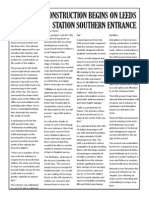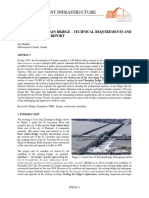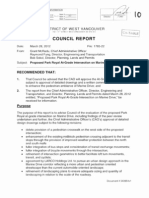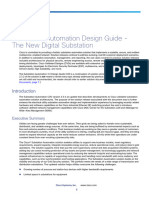Bridge Replacement Fact Sheet
Bridge Replacement Fact Sheet
Uploaded by
Metro Los AngelesCopyright:
Available Formats
Bridge Replacement Fact Sheet
Bridge Replacement Fact Sheet
Uploaded by
Metro Los AngelesOriginal Description:
Copyright
Available Formats
Share this document
Did you find this document useful?
Is this content inappropriate?
Copyright:
Available Formats
Bridge Replacement Fact Sheet
Bridge Replacement Fact Sheet
Uploaded by
Metro Los AngelesCopyright:
Available Formats
Caltrans Metro Port of Long Beach US Department of Transportation
Fact Sheet
An artists rendering shows the preliminary design of a new six-lane, cable-stayed bridge that will replace the Gerald Desmond Bridge.
he Gerald Desmond Bridge has become a vital part of the nations infrastructure, with nearly 15 percent of the nations waterborne cargo trucked across the bridge. It is a critical access route for the Port of Long Beach, downtown Long Beach and surrounding communities. But the Desmond Bridge, which opened in 1968, is nearing the end of its intended lifespan. It was not designed to handle todays traffic volumes. With that in mind, the California Department of Transportation (Caltrans) and the Port of Long Beach have begun a project to replace the Desmond Bridge. The project is a joint effort of Caltrans and the Port, with funding also from the U.S. Department of Transportation and the Los Angeles County Metropolitan Transportation Authority (Metro).
The aging Gerald Desmond Bridge faces traffic and maintenance issues. The new bridge will be designed to meet the regions transportation and cargo-movement needs for many years to come. Construction of the new bridge is expected to take four years, starting in early 2013. Once the new bridge is completed and open, the old bridge will be taken down. The new bridge will be built with a cable-stayed design. With 200 feet of clearance over the water, the new bridge will be high enough to accommodate the newest generation of the most-efficient cargo ships. And with three lanes in each direction plus safety lanes, it will be wider and better able to serve the thousands of cars and trucks that use the bridge each day. (continued on back)
updated 5.18.12
Officials gather at a kickoff event to launch the Gerald Desmond Bridge Replacement Project. The route is an important one. The Desmond Bridge has been designated as a National Highway System Intermodal Connector Route and part of the Federal Strategic Highway Network. It is a critical structure serving the ports of Long Beach and Los Angeles, the City of Long Beach, Los Angeles and Orange counties and the nation. While the old bridge is safe for commuters today, it is rapidly deteriorating. Even with costly maintenance, the old bridge cannot be sustained. Deteriorating physical condition. Protective netting has been installed under sections of the bridge to stop falling pieces of concrete from hitting workers, the ground or waterways below.
Economic Impact
The bridge project will generate about 4,000 jobs a year for the five years of building the new bridge and taking the old one down.
Replacement Project
The new bridge will include: Three lanes in each direction for improved traffic flow. Emergency lanes on both sides to reduce traffic delays and safety hazards from accidents and vehicle breakdowns. A 200-foot vertical clearance that would accommodate newer, greener vessels. A reduction in the bridges steep grades, for further improvements to traffic flow. Additional improvements include reconstruction of the Terminal Island East Interchange and the I-710/Gerald Desmond Bridge Interchange. Plans and cost estimates for a bikeway will also be incorporated into the design.
Next Steps
Using the design-build process, Caltrans and the Port in September 2011 issued a Request for Proposals to a group of pre-qualified engineeringconstruction teams. Three designbuild proposals were submitted by the March 2, 2012 deadline. The designbuild method combines both design and construction into one contract to expedite the construction process and potentially reduce project costs. The Project Selection Committee, led by Caltrans, the Port and Metro, recommended the proposal by the joint venture team of Shimmick Construction, FCC Construction and Impregilo S.p.A., as the best value proposal. The Long Beach Board of Harbor Commissioners in May 2012 issued a notice of intent to contract with the team. A board decision on awarding the contract is expected by early July 2012. Construction would likely begin in mid-2013.
Background
The Gerald Desmond Bridge has several critical operational issues and maintenance challenges: Traffic has exceeded capacity. The bridge now handles as many as 68,000 vehicle trips a day and about 18 million trips a year. Regional commuter traffic accounts for about 75 percent of bridge traffic. Very low ratings by Caltrans inspectors. The bridge received a low sufficiency rating by Caltrans, 48 out of 100. The bridge received low marks in inspections of the concrete decks and superstructure.
For more information about this project, visit www.newgdbridge.com
You might also like
- Kerajaan Malaysia (Jabatan Kerja Raya) V Global Globe (M) SDN BHDDocument26 pagesKerajaan Malaysia (Jabatan Kerja Raya) V Global Globe (M) SDN BHDSrikumar Ramesh100% (6)
- FrontmatterDocument23 pagesFrontmattermandamantoNo ratings yet
- SmartUP Manuale Installazione - GB - Rev5. 111120Document11 pagesSmartUP Manuale Installazione - GB - Rev5. 111120Emilio CortesNo ratings yet
- LSZH ZurichDocument85 pagesLSZH ZurichBurakETCNo ratings yet
- Final 2021 2024 Coordinated Public Transit PlanDocument63 pagesFinal 2021 2024 Coordinated Public Transit PlanMetro Los AngelesNo ratings yet
- Metro Board of Directors April 2021 Meeting AgendaDocument17 pagesMetro Board of Directors April 2021 Meeting AgendaMetro Los AngelesNo ratings yet
- LA Metro Recovery Task Force Draft Final ReportDocument110 pagesLA Metro Recovery Task Force Draft Final ReportMetro Los AngelesNo ratings yet
- Moving Beyond Sustainability Strategic PlanDocument112 pagesMoving Beyond Sustainability Strategic PlanMetro Los AngelesNo ratings yet
- ChillerDocument3 pagesChillerRomie CubalNo ratings yet
- HW 1 Isd 520 PDFDocument4 pagesHW 1 Isd 520 PDFChiragNo ratings yet
- Ms NewsNotes Fall 2009Document12 pagesMs NewsNotes Fall 2009ms consultants100% (1)
- Hampton Roads Bridge Tunnel Expansion Project ReviewDocument10 pagesHampton Roads Bridge Tunnel Expansion Project ReviewTati MoraNo ratings yet
- Can Marine Highways Deliver, January 14, 2010Document15 pagesCan Marine Highways Deliver, January 14, 2010Chuck AchbergerNo ratings yet
- NYSDOT - Dunn Memorial BridgeDocument2 pagesNYSDOT - Dunn Memorial BridgeTime Warner Cable NewsNo ratings yet
- Edmonton Light Rail Transit (LRT) OverviewDocument87 pagesEdmonton Light Rail Transit (LRT) OverviewdanielNo ratings yet
- Construction Begins On Leeds Station Southern Entrance: by Alex HarterDocument1 pageConstruction Begins On Leeds Station Southern Entrance: by Alex HarterAlexHarterNo ratings yet
- 422 Term Project Spring 2020 Fully CompletedDocument10 pages422 Term Project Spring 2020 Fully Completedapi-549887775No ratings yet
- Panama Canal Expansion and Port Cities Pollution - December 2012Document4 pagesPanama Canal Expansion and Port Cities Pollution - December 2012CJ SchexnayderNo ratings yet
- Southeast Boulevard Feasibility Study Final DraftDocument29 pagesSoutheast Boulevard Feasibility Study Final DraftAnacostiaWaterfrontNo ratings yet
- Resilient Infrastructure: The New Champlain Bridge - Technical Requirements and Delivery Status ReportDocument12 pagesResilient Infrastructure: The New Champlain Bridge - Technical Requirements and Delivery Status Reportma baNo ratings yet
- Council Evaluation)Document45 pagesCouncil Evaluation)Prasanna SrirangamNo ratings yet
- Covell EaDocument204 pagesCovell Eacebuano88No ratings yet
- 06 SEATTLE Case Studies in Urban Freeway RemovalDocument38 pages06 SEATTLE Case Studies in Urban Freeway Removalevanj232No ratings yet
- Ncdot Connect Construction ManualDocument6 pagesNcdot Connect Construction Manualnoahyosef456No ratings yet
- Highway Engineering Cv0503 Unit 1Document18 pagesHighway Engineering Cv0503 Unit 1gopal palNo ratings yet
- 12 14 10 Grain Elevator InspectionDocument2 pages12 14 10 Grain Elevator InspectionAddy P EsdnyNo ratings yet
- 2011 House Submits To CommitteeDocument16 pages2011 House Submits To CommitteeehllNo ratings yet
- Prairie Street OverpassDocument8 pagesPrairie Street OverpasselkharttruthNo ratings yet
- DTLB Resolutions 2016-19 Re Lake RDDocument5 pagesDTLB Resolutions 2016-19 Re Lake RDGeorge WoodNo ratings yet
- Minto Island Bridge Master PlanDocument17 pagesMinto Island Bridge Master PlanStatesman JournalNo ratings yet
- Innovative Construction: Milton-Madison BridgeDocument3 pagesInnovative Construction: Milton-Madison Bridgejunaid112No ratings yet
- A and B LoopDocument9 pagesA and B LoopOrgito LekaNo ratings yet
- Proposal: To Develop The Metrorail: A Rapid Transit System To Serve Washington D.CDocument8 pagesProposal: To Develop The Metrorail: A Rapid Transit System To Serve Washington D.CAnonymous VmN1e4LEjjNo ratings yet
- $16b Hudson Tunnel Gets Massive Federal Grant For Us TransitDocument4 pages$16b Hudson Tunnel Gets Massive Federal Grant For Us TransitMohamed BalahaNo ratings yet
- WT0802Document27 pagesWT0802gzapasNo ratings yet
- Paul Case2Document5 pagesPaul Case2api-302917858No ratings yet
- A. Napoleon The Great-The Current Route Napoléon, First Opened in 1932, Follows The RouteDocument5 pagesA. Napoleon The Great-The Current Route Napoléon, First Opened in 1932, Follows The RouteMikaella TambisNo ratings yet
- Reinforced Concrete PavementDocument13 pagesReinforced Concrete Pavementvish5610100% (1)
- DOD - Handbook of Paints & CoatingsDocument20 pagesDOD - Handbook of Paints & Coatingsjohn_p47No ratings yet
- Assignment 7: End - Project Report: Ct3101 Basisapsecten Projectmanagement Group 9BDocument8 pagesAssignment 7: End - Project Report: Ct3101 Basisapsecten Projectmanagement Group 9BliseNo ratings yet
- Article Q3L10Document4 pagesArticle Q3L10tra221586hniNo ratings yet
- 04 03 TransportationDocument45 pages04 03 TransportationRecordTrac - City of OaklandNo ratings yet
- G Perelmuter Et AlDocument12 pagesG Perelmuter Et AlAndy AcousticNo ratings yet
- 2019 HWY18MH009 BMG AbstractDocument7 pages2019 HWY18MH009 BMG AbstractBryan VillalobosNo ratings yet
- Common Concerns and QuestionsDocument5 pagesCommon Concerns and QuestionsIsabelle PasciollaNo ratings yet
- Case Neg - ArmycorpsDocument4 pagesCase Neg - ArmycorpsElias GarciaNo ratings yet
- Unique New Bridge Designs For Four Highway Interchanges in BCDocument17 pagesUnique New Bridge Designs For Four Highway Interchanges in BCShaileshRastogiNo ratings yet
- Civil Engineering Construction Project Sample ProposalDocument15 pagesCivil Engineering Construction Project Sample Proposaltesfalem kirosNo ratings yet
- Concrete U-Girder - EnR May 2017Document2 pagesConcrete U-Girder - EnR May 2017saritasohamNo ratings yet
- Roads Construction InsuranceDocument48 pagesRoads Construction InsurancevojislavsNo ratings yet
- WPMP FaqDocument3 pagesWPMP FaqSummit FourthNo ratings yet
- DOCMENTDocument144 pagesDOCMENTsuleyman ahmedNo ratings yet
- INLAND PORT PROJECT FinalDocument16 pagesINLAND PORT PROJECT FinalJonathan Williams100% (3)
- Waterway Lock ProjectsDocument20 pagesWaterway Lock ProjectsPiney MartinNo ratings yet
- Project Overview & SuppliersDocument19 pagesProject Overview & SuppliersNatala WillzNo ratings yet
- Bridge ConstructionDocument12 pagesBridge Constructionashishnaval_29No ratings yet
- River Valley Road/Groat Road InterchangeDocument2 pagesRiver Valley Road/Groat Road InterchangeEdmonton SunNo ratings yet
- City of Surrey Report and Agreement On Pattullo BridgeDocument11 pagesCity of Surrey Report and Agreement On Pattullo BridgeJeff NagelNo ratings yet
- Costo de Puentes en Base A LuzDocument33 pagesCosto de Puentes en Base A LuzDEYBI ALEJANDRO CHINCHAY POMANo ratings yet
- Design of Very Long Bridge - Neil TincknellDocument13 pagesDesign of Very Long Bridge - Neil TincknellMaitrabarun KarjeeNo ratings yet
- A Bridge Too Exclusive For CarsDocument3 pagesA Bridge Too Exclusive For CarsThomas ArfiantoNo ratings yet
- Background of The StudyDocument42 pagesBackground of The StudyOral Paul M. MarzanNo ratings yet
- Green Line To LAX Fact SheetDocument2 pagesGreen Line To LAX Fact SheetMetro Los AngelesNo ratings yet
- Information From High Steel Structures Inc.: Golden Gate BridgeDocument6 pagesInformation From High Steel Structures Inc.: Golden Gate BridgeponjoveNo ratings yet
- Modified V-AW, For Elected OfficialsDocument19 pagesModified V-AW, For Elected OfficialsJohanna Ferebee StillNo ratings yet
- Case Study Project ManagementDocument2 pagesCase Study Project ManagementHoa Quỳnh0% (1)
- Transactions of the American Society of Civil Engineers, Vol. LXVIII, Sept. 1910 The New York Tunnel Extension of the Pennsylvania Railroad. Paper No. 1150From EverandTransactions of the American Society of Civil Engineers, Vol. LXVIII, Sept. 1910 The New York Tunnel Extension of the Pennsylvania Railroad. Paper No. 1150No ratings yet
- Motor Truck Logging Methods Engineering Experiment Station Series, Bulletin No. 12From EverandMotor Truck Logging Methods Engineering Experiment Station Series, Bulletin No. 12No ratings yet
- Metro Board of Directors Aug. 2022 AgendaDocument19 pagesMetro Board of Directors Aug. 2022 AgendaMetro Los AngelesNo ratings yet
- Metro Board of Directors March 2022 Meeting AgencaDocument14 pagesMetro Board of Directors March 2022 Meeting AgencaMetro Los AngelesNo ratings yet
- Metro Board of Directors June 2022 Meeting AgendaDocument25 pagesMetro Board of Directors June 2022 Meeting AgendaMetro Los AngelesNo ratings yet
- Metro Board of Directors Agenda - September 2021 MeetingDocument17 pagesMetro Board of Directors Agenda - September 2021 MeetingMetro Los AngelesNo ratings yet
- Go To This Link To Download The AgendaDocument2 pagesGo To This Link To Download The AgendaMetro Los AngelesNo ratings yet
- Metro Board of Directors - Regular Board Meeting April 2022Document21 pagesMetro Board of Directors - Regular Board Meeting April 2022Metro Los AngelesNo ratings yet
- Metro Board of Directors, Feb. 2022 MeetingDocument16 pagesMetro Board of Directors, Feb. 2022 MeetingMetro Los AngelesNo ratings yet
- Metro Board of Directors Oct 2021 AgendaDocument18 pagesMetro Board of Directors Oct 2021 AgendaMetro Los AngelesNo ratings yet
- Board of Directors - Regular Board MeetingDocument24 pagesBoard of Directors - Regular Board MeetingMetro Los AngelesNo ratings yet
- Metro FY22 Budget - Outreach Presentation - FinalDocument18 pagesMetro FY22 Budget - Outreach Presentation - FinalMetro Los AngelesNo ratings yet
- Feb. 2021 Metro Board of Directors AgendaDocument18 pagesFeb. 2021 Metro Board of Directors AgendaMetro Los AngelesNo ratings yet
- Metro Board of Directors Agenda June 2021 MeetingDocument28 pagesMetro Board of Directors Agenda June 2021 MeetingMetro Los AngelesNo ratings yet
- RECAP of Proceedings - Metro Board April 2021 MeetingDocument12 pagesRECAP of Proceedings - Metro Board April 2021 MeetingMetro Los AngelesNo ratings yet
- Metro Board of Directors July 2021 Meeting AgendaDocument18 pagesMetro Board of Directors July 2021 Meeting AgendaMetro Los AngelesNo ratings yet
- Los Angeles-Total Remote WorkDocument50 pagesLos Angeles-Total Remote WorkMetro Los Angeles100% (1)
- Metro Board of Directors May 2021 Meeting AgendaDocument25 pagesMetro Board of Directors May 2021 Meeting AgendaMetro Los AngelesNo ratings yet
- Recovery Task Force ReportDocument113 pagesRecovery Task Force ReportMetro Los AngelesNo ratings yet
- Attachment ADocument87 pagesAttachment AMetro Los AngelesNo ratings yet
- Goods Movement Strategic PlanDocument54 pagesGoods Movement Strategic PlanMetro Los Angeles100% (1)
- Metro Board of Directors March 2021 MeetingDocument18 pagesMetro Board of Directors March 2021 MeetingMetro Los AngelesNo ratings yet
- RECAP of Proceedings - March 25, 2021Document19 pagesRECAP of Proceedings - March 25, 2021Metro Los AngelesNo ratings yet
- Metro Board of Directors Meeting Agenda, January 2021Document21 pagesMetro Board of Directors Meeting Agenda, January 2021Metro Los AngelesNo ratings yet
- Metro Budget Presentation Sept. 2020Document14 pagesMetro Budget Presentation Sept. 2020Metro Los AngelesNo ratings yet
- Jan. 2021 Metro Board of Directors Meeting RecapDocument19 pagesJan. 2021 Metro Board of Directors Meeting RecapMetro Los AngelesNo ratings yet
- Agenda For Metro Board of Directors Meeting For Oct. 2020Document19 pagesAgenda For Metro Board of Directors Meeting For Oct. 2020Metro Los AngelesNo ratings yet
- Metro Use of Force PresentationDocument7 pagesMetro Use of Force PresentationMetro Los AngelesNo ratings yet
- Full Spelling For Literacy For Ages 10 11 Brodie Ebook All ChaptersDocument84 pagesFull Spelling For Literacy For Ages 10 11 Brodie Ebook All ChaptersyiingakyurtNo ratings yet
- Genetically Modified Organisms GmosDocument14 pagesGenetically Modified Organisms Gmosaditi_joshee419No ratings yet
- Understanding The Anatomy of Forex MarketDocument6 pagesUnderstanding The Anatomy of Forex MarketRenatoNo ratings yet
- Chapter 5 Interviewing CandidatesDocument20 pagesChapter 5 Interviewing CandidatesBending ExistenceNo ratings yet
- Nautical TermsDocument33 pagesNautical TermsJose Manuel Guerrero JiménezNo ratings yet
- Atmnirbhar Bharat - 20 LAC Cr. Financial Package by GOIDocument10 pagesAtmnirbhar Bharat - 20 LAC Cr. Financial Package by GOIpriti.shahNo ratings yet
- COA v. Province of CebuDocument2 pagesCOA v. Province of CebuJemson Ivan Walcien100% (3)
- LTE Handover Call FlowDocument11 pagesLTE Handover Call FlowDhiraj Singh100% (1)
- Process LayoutDocument1 pageProcess LayoutKundan SavaliyaNo ratings yet
- AIB-2023-DPES-CNMC Spain Domain Protocol 26012023Document49 pagesAIB-2023-DPES-CNMC Spain Domain Protocol 26012023biyiudNo ratings yet
- JURNALDocument16 pagesJURNALKamil AhmadNo ratings yet
- ZeTimeUser Guide enDocument45 pagesZeTimeUser Guide enmurphyjimNo ratings yet
- Questions On Triumph of The Nerds & Pirates of Silicon ValleyDocument5 pagesQuestions On Triumph of The Nerds & Pirates of Silicon ValleyhockendougalNo ratings yet
- Department of Civil Engineering Curriculum & Syllabi R-2013 For B.E Civil Engineering Semester - I Course Code Course L T P C TheoryDocument50 pagesDepartment of Civil Engineering Curriculum & Syllabi R-2013 For B.E Civil Engineering Semester - I Course Code Course L T P C TheorygggNo ratings yet
- FIVB Volleyball Homologation Procedures PDFDocument13 pagesFIVB Volleyball Homologation Procedures PDFDonNo ratings yet
- Overvieww of AIM Methodology OracleDocument3 pagesOvervieww of AIM Methodology OracletsurendarNo ratings yet
- Information Security PolicyDocument19 pagesInformation Security PolicyVarun UpadhyayNo ratings yet
- 4X2 3.2 Tons Cargo Boom TruckDocument1 page4X2 3.2 Tons Cargo Boom TruckGreen ArcticNo ratings yet
- Sandvik DL430Document2 pagesSandvik DL430Nelson MezaNo ratings yet
- ChiefMate Phase 2 II Question Papers Bank Till Feb19 DG SHIPPING INDIADocument189 pagesChiefMate Phase 2 II Question Papers Bank Till Feb19 DG SHIPPING INDIAGurjit Singh100% (6)
- Substation Automation GuideDocument70 pagesSubstation Automation GuideMahruos ElshabrawyNo ratings yet
- Invitation-MS Proving GroundDocument2 pagesInvitation-MS Proving GroundPradiptaAdiPamungkas100% (1)
- Design of Urban and Regional Nodes AssI PDFDocument5 pagesDesign of Urban and Regional Nodes AssI PDFSemira HusenNo ratings yet
- Artist Management AgreementDocument4 pagesArtist Management Agreementqweryu334No ratings yet
- Ctms For IcriDocument70 pagesCtms For IcrisomcologyNo ratings yet























































































































